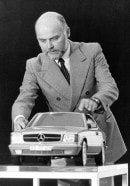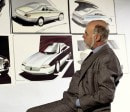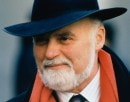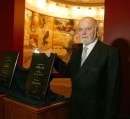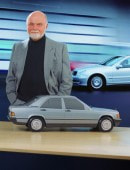He was the man responsible with the Mercedes-Benz design cohesion over the last part of the twentieth century. A red-blooded Italian with a teutonic sense of detail, what more would a manufacturer want from its chief designer?
Bruno Sacco was born in the province of Udine, Italy, on the 12th of November 1933. His great affection towards automobiles started from somewhat of an early age, right after observing a Studebaker Commander Regal passing him on the streets of the city of Tarvisio. In his own words, the Raymond Loewy-designed Studebaker marked Sacco for life and persuaded him to follow a career in automotive design.
He attended the Technical University of Turin and during his studies he started doing body design for the illustrious Ghia design house. After graduation, he did a little work in both Ghia and Pininfarina companies but in 1958 moved to Germany, where he got a job as a stylist and engineer at Daimler-Benz. He was only 24 years old.
Initially, his plan was to stay long enough to gain experience, but this all changed after he met Annemarie lbe in 1959, who became his wife and gave birth to their daughter Marina the following year.
Following in the footsteps of Friedrich Geiger, who had just been nominated chief designer at Mercedes-Benz after a 25 year stint with the German company, Bruno Sacco established his own innovative line of design over the next period.
Carrying small design and engineering tasks on a number of projects in the next few years, Sacco rose through the corporate ranks and eventually became chief of the Body and Dimensional Design department in 1970. Five years later he took over from Friedrich Geiger as chief of the Styling Department for all Daimler-Benz vehicles, a position he would occupy until 1999.
Just like a lot of other automotive designers, Bruno Sacco was a forward-thinker. What really set him apart was the way he instructed his army of designers to think ahead. Most automotive designers conceptualize models between five and ten years into the future, but Sacco increased that amount of time to an astonishing three decades in order to actually create timeless designs. “The development cycle for a new vehicle is typically three to five years,” Sacco used to explain. “This is then followed by a production life of about eight years. The last car off the assembly line will have an average life expectancy of twenty years. That adds up to a product life cycle of approximately 30 years!”
His most famous design philosophy was that “a Mercedes-Benz should always look like a Mercedes-Benz”, no matter the era when it was built. Moreover, since he had also studied the technical part in doing a design project, he had always been a strong believer in the notion that design and technical innovation work hand in hand. “I am well aware that this contradicts the famous ‘form follows function’ dictum of the American architect Louis Sullivan,” Sacco once said. “But for us, there is no primacy of technology over design or of design over technology. The aesthetics of a product can never hope to make up for poor-quality technology.”
His long campaigned for “horizontal and vertical affinity” terms were used to describe the homogeneity and continuity of Mercedes-Benz designs over the years. He described the “horizontal affinity” as the common design cues between all the models in the Mercedes-Benz range, therefore creating a a powerful visual relationship between all the cars. In fewer words, this became known as common brand image between distinct models of the same manufacturer.
The “vertical affinity” was the prerequisite for models not to be automatically rendered as a stylistic fossil each time a successor would appear, ensuring the timelessness of the designs. Sacco knew this was a very important desideratum for Mercedes-Benz, since the brand's status of longevity and reliability meant that the typical life cycle for a model was of a few decades.
Since he had been responsible for the overall look of every Mercedes-Benz automobile, bus or truck for more than 25 years, he created his own mark and instituted a design language that is now highly regarded in the automotive world of designers. His most famous works include the Mercedes 600 W100 and the 230 SL “Pagoda” W113 roadster under the helm of Friedrich Geiger's guiding hands.
After becoming the chief designer for the whole company he penned a lot of other iconic models, like three generations of Mercedes-S-Class (W126, W140 and the W220), the R129 SL roadster, the first C-Clas (W202), the C208 and A208 CLK, R170 SLK roadster, the first M-Class (W163) and he even put the finishing touches on the smart city coupe.
Mainly because its significance to the company, his favorite design work was on the Mercedes-Benz 190 (W201), while his opinion about the finished product consisting of the W140 S-Class was that it could have been his best work if it hadn't been “four inches too tall”. It had taken Sacco several years in the beginning of his career to actually understand the Damler-Benz culture, but the only value he was going to follow consisted of Gottlieb Daimler's own words for his company: “nothing but the best”.
After 40 years, 24 as the chief designer, in which he created the distinct Mercedes-Benz image we all know today, Bruno Sacco retired, but not before receiving enough achievement awards to fill-up an entire trophy wall. He is now doing industrial design but he will always have a place in the designer's hall of fame, and his timeless designs will continue to inspire generations to come.
He attended the Technical University of Turin and during his studies he started doing body design for the illustrious Ghia design house. After graduation, he did a little work in both Ghia and Pininfarina companies but in 1958 moved to Germany, where he got a job as a stylist and engineer at Daimler-Benz. He was only 24 years old.
Initially, his plan was to stay long enough to gain experience, but this all changed after he met Annemarie lbe in 1959, who became his wife and gave birth to their daughter Marina the following year.
Following in the footsteps of Friedrich Geiger, who had just been nominated chief designer at Mercedes-Benz after a 25 year stint with the German company, Bruno Sacco established his own innovative line of design over the next period.
Carrying small design and engineering tasks on a number of projects in the next few years, Sacco rose through the corporate ranks and eventually became chief of the Body and Dimensional Design department in 1970. Five years later he took over from Friedrich Geiger as chief of the Styling Department for all Daimler-Benz vehicles, a position he would occupy until 1999.
Just like a lot of other automotive designers, Bruno Sacco was a forward-thinker. What really set him apart was the way he instructed his army of designers to think ahead. Most automotive designers conceptualize models between five and ten years into the future, but Sacco increased that amount of time to an astonishing three decades in order to actually create timeless designs. “The development cycle for a new vehicle is typically three to five years,” Sacco used to explain. “This is then followed by a production life of about eight years. The last car off the assembly line will have an average life expectancy of twenty years. That adds up to a product life cycle of approximately 30 years!”
His most famous design philosophy was that “a Mercedes-Benz should always look like a Mercedes-Benz”, no matter the era when it was built. Moreover, since he had also studied the technical part in doing a design project, he had always been a strong believer in the notion that design and technical innovation work hand in hand. “I am well aware that this contradicts the famous ‘form follows function’ dictum of the American architect Louis Sullivan,” Sacco once said. “But for us, there is no primacy of technology over design or of design over technology. The aesthetics of a product can never hope to make up for poor-quality technology.”
His long campaigned for “horizontal and vertical affinity” terms were used to describe the homogeneity and continuity of Mercedes-Benz designs over the years. He described the “horizontal affinity” as the common design cues between all the models in the Mercedes-Benz range, therefore creating a a powerful visual relationship between all the cars. In fewer words, this became known as common brand image between distinct models of the same manufacturer.
The “vertical affinity” was the prerequisite for models not to be automatically rendered as a stylistic fossil each time a successor would appear, ensuring the timelessness of the designs. Sacco knew this was a very important desideratum for Mercedes-Benz, since the brand's status of longevity and reliability meant that the typical life cycle for a model was of a few decades.
Since he had been responsible for the overall look of every Mercedes-Benz automobile, bus or truck for more than 25 years, he created his own mark and instituted a design language that is now highly regarded in the automotive world of designers. His most famous works include the Mercedes 600 W100 and the 230 SL “Pagoda” W113 roadster under the helm of Friedrich Geiger's guiding hands.
After becoming the chief designer for the whole company he penned a lot of other iconic models, like three generations of Mercedes-S-Class (W126, W140 and the W220), the R129 SL roadster, the first C-Clas (W202), the C208 and A208 CLK, R170 SLK roadster, the first M-Class (W163) and he even put the finishing touches on the smart city coupe.
Mainly because its significance to the company, his favorite design work was on the Mercedes-Benz 190 (W201), while his opinion about the finished product consisting of the W140 S-Class was that it could have been his best work if it hadn't been “four inches too tall”. It had taken Sacco several years in the beginning of his career to actually understand the Damler-Benz culture, but the only value he was going to follow consisted of Gottlieb Daimler's own words for his company: “nothing but the best”.
After 40 years, 24 as the chief designer, in which he created the distinct Mercedes-Benz image we all know today, Bruno Sacco retired, but not before receiving enough achievement awards to fill-up an entire trophy wall. He is now doing industrial design but he will always have a place in the designer's hall of fame, and his timeless designs will continue to inspire generations to come.

